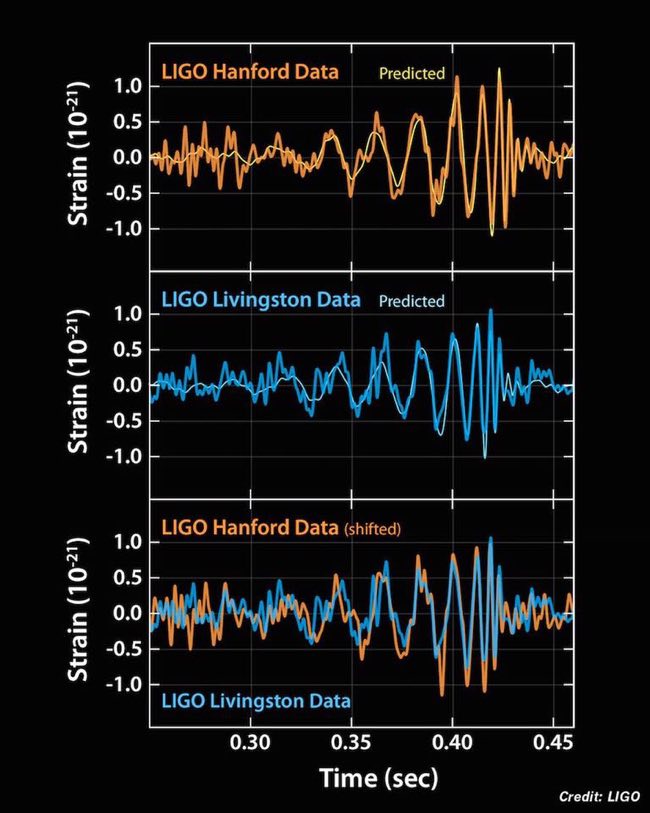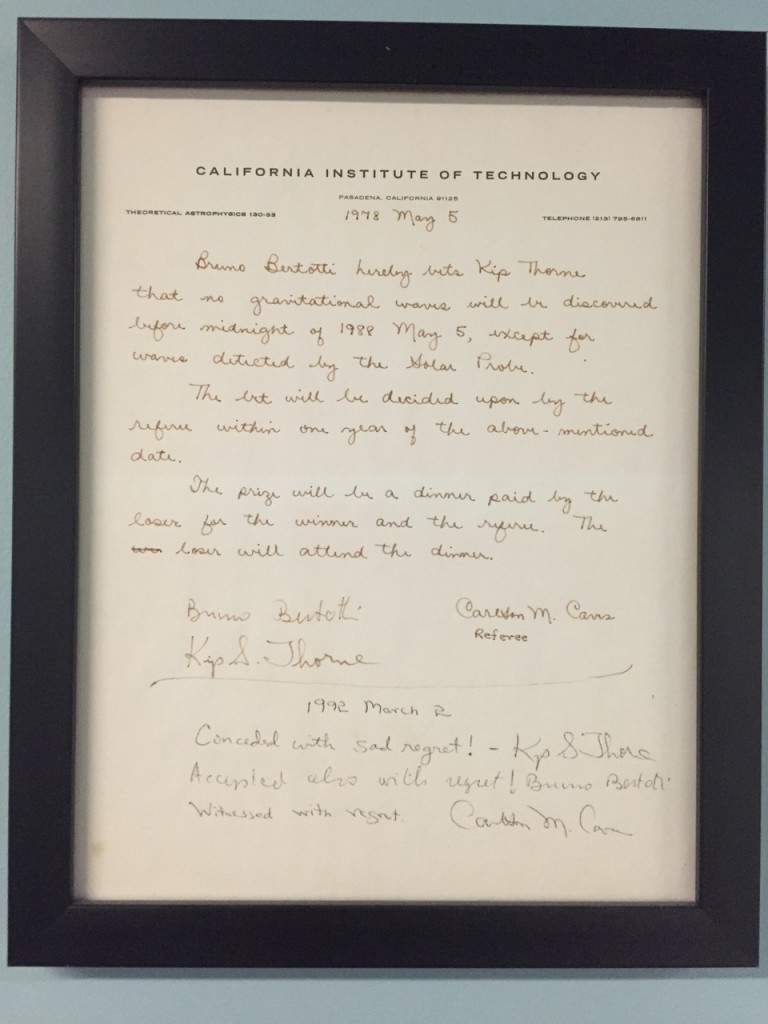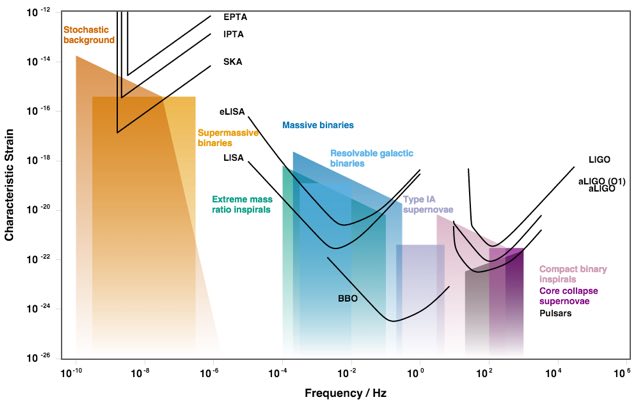ONCE upon a time, there lived a man who was fascinated by the phenomenon of gravity. In his mind he imagined experiments in rocket ships and elevators, eventually concluding that gravity isn’t a conventional “force” at all — it’s a manifestation of the curvature of spacetime. He threw himself into the study of differential geometry, the abstruse mathematics of arbitrarily curved manifolds. At the end of his investigations he had a new way of thinking about space and time, culminating in a marvelous equation that quantified how gravity responds to matter and energy in the universe.
Not being one to rest on his laurels, this man worked out a number of consequences of his new theory. One was that changes in gravity didn’t spread instantly throughout the universe; they traveled at the speed of light, in the form of gravitational waves. In later years he would change his mind about this prediction, only to later change it back. Eventually more and more scientists became convinced that this prediction was valid, and worth testing. They launched a spectacularly ambitious program to build a technological marvel of an observatory that would be sensitive to the faint traces left by a passing gravitational wave. Eventually, a century after the prediction was made — a press conference was called.
Chances are that everyone reading this blog post has heard that LIGO, the Laser Interferometric Gravitational-Wave Observatory, officially announced the first direct detection of gravitational waves. Two black holes, caught in a close orbit, gradually lost energy and spiraled toward each other as they emitted gravitational waves, which zipped through space at the speed of light before eventually being detected by our observatories here on Earth. Plenty of other places will give you details on this specific discovery, or tutorials on the nature of gravitational waves, including in user-friendly comic/video form.
What I want to do here is to make sure, in case there was any danger, that nobody loses sight of the extraordinary magnitude of what has been accomplished here. We’ve become a bit blasé about such things: physics makes a prediction, it comes true, yay. But we shouldn’t take it for granted; successes like this reveal something profound about the core nature of reality.
Some guy scribbles down some symbols in an esoteric mixture of Latin, Greek, and mathematical notation. Scribbles originating in his tiny, squishy human brain. (Here are what some of those those scribbles look like, in my own incredibly sloppy handwriting.) Other people (notably Rainer Weiss, Ronald Drever, and Kip Thorne), on the basis of taking those scribbles extremely seriously, launch a plan to spend hundreds of millions of dollars over the course of decades. They concoct an audacious scheme to shoot laser beams at mirrors to look for modulated displacements of less than a millionth of a billionth of a centimeter — smaller than the diameter of an atomic nucleus. Meanwhile other people looked at the sky and tried to figure out what kind of signals they might be able to see, for example from the death spiral of black holes a billion light-years away. You know, black holes: universal regions of death where, again according to elaborate theoretical calculations, the curvature of spacetime has become so pronounced that anything entering can never possibly escape. And still other people built the lasers and the mirrors and the kilometers-long evacuated tubes and the interferometers and the electronics and the hydraulic actuators and so much more, all because they believed in those equations. And then they ran LIGO (and other related observatories) for several years, then took it apart and upgraded to Advanced LIGO, finally reaching a sensitivity where you would expect to see real gravitational waves if all that fancy theorizing was on the right track.
And there they were. On the frikkin’ money.
Our universe is mind-bogglingly vast, complex, and subtle. It is also fantastically, indisputably knowable.

I got a hard time a few years ago for predicting that we would detect gravitational waves within five years. And indeed, the track record of such predictions has been somewhat spotty. Outside Kip Thorne’s office you can find this record of a lost bet — after he predicted that we would see them before 1988. (!)
But this time around I was pretty confident. The existence of overly-optimistic predictions in the past doesn’t invalidate the much-better predictions we can make with vastly updated knowledge. Advanced LIGO represents the first time when we would have been more surprised not to see gravitational waves than to have seen them. And I believed in those equations.
I don’t want to be complacent about it, however. The fact that Einstein’s prediction has turned out to be right is an enormously strong testimony to the power of science in general, and physics in particular, to describe our natural world. Einstein didn’t know about black holes; he didn’t even know about lasers, although it was his work that laid the theoretical foundations for both ideas. He was working at a level of abstraction that reached as far as he could (at the time) to the fundamental basis of things, how our universe works at the deepest of levels. And his theoretical insights were sufficiently powerful and predictive that we could be confident in testing them a century later. This seemingly effortless insight that physics gives us into the behavior of the universe far away and under utterly unfamiliar conditions should never cease to be a source of wonder.
We’re nowhere near done yet, of course. We have never observed the universe in gravitational waves before, so we can’t tell for sure what we will see, but plausible estimates predict between one-half and several hundred events per year. Hopefully, the success of LIGO will invigorate interest in other ways of looking for gravitational waves, including at very different wavelengths. Here’s a plot focusing on three regimes: LIGO and its cousins on the right, the proposed space-based observatory LISA in the middle, and pulsar-timing arrays (using neutron stars throughout the galaxy as a giant gravitational-wave detector) on the left. Colorful boxes are predicted sources; solid lines are the sensitivities of different experiments. Gravitational-wave astrophysics has just begun; asking us what we will find is like walking up to Galileo and asking him what else you could discover with telescopes other than moons around Jupiter.
For me, the decade of the 2010’s opened with five big targets in particle physics/gravitation/cosmology:
- Discover the Higgs boson.
- Directly detect gravitational waves.
- Directly observe dark matter.
- Find evidence of inflation (e.g. tensor modes) in the CMB.
- Discover a particle not in the Standard Model.
The decade is about half over, and we’ve done two of them! Keep up the good work, observers and experimentalists, and the 2010’s will go down as a truly historic decade in physics.



I am trying to work out why I am not excited at this. It seems like it would have been more interesting at this stage if they hadn’t found gravitational waves.
Hi Sean,
Long-time reader, first-time poster! I have a silly question about the merger. You’ve got two in-spiralling black holes, one with a mass of 36 solar masses and the other with a mass of 29 solar masses. Afterwards, you have one black hole with a mass of 62 solar masses and 3 solar masses of outgoing radiation. Here’s my question: by definition, nothing can escape from a black hole (at least, classically), so it seems like your final product should be one black hole with a mass of 65 solar masses; instead, it seems like 3 solar masses of material is escaping from inside the black holes via gravitational waves. How is that possible?
Or, maybe, when people say that the mass of one black hole is 36 solar masses, do they really mean the energy (gravitational, pressure, rotation, etc.)/c^2 contained within the orbit of some test particle? In that case, I can understand how the “mass” decreases as energy is radiated away during the merger.
Best regards and thanks in advance!
Steve
“plausible estimates predict between one-half and several hundred events per year”.
With the current sensitivity, apparently tens per year, they found a large mass merger quickly and apparently there are 4 or more candidates in the full run claimed in some media event. (I am lost among the many tabs I opened; but i do see that the paper is only on the first merger.) I assume that frequency/volume is what Kip Thorne relied on when he claimed a 3 times larger sensitivity is target, meaning seeing ~ 30 times more volume, and promised up to a 1000 mergers/year!
@James Goetz: I dunno what Sean would say, but gravitons were not detected as of yet. There is nothing of the quantized nature that shows up directly what I know of, except Kip Thorne noted a best yet constraint on how massive gravitons could be.
But if they were, they should be the wild card in the SM description they are often depicted as, loosely associated. (Not much of a part of the semiclassical model, though you can derive them for a weak gravity field approximation, see Distler’s blog. But classical GR, the background, is a part. So you can stick gravitons in. Or not.)
@WiseApe: “I understand why they’re not faster, but not why they’re as fast.”
If they are long range, they can’t have invariant mass or they would die out as short range on a spacetime background. I think, it is late so I am handwaving this due to I am falling asleep and can’t brain anymore. Cf photons.
No invariant mass means traveling at the universal speed limit.
What an amazing accomplishment. From Gauss to Einstein to Pirani and Thorne and thousands of engineers and technicians. Something the human race can be proud of.
I’m curious whether someone (who knows more than the almost nothing that I know about theoretical physics) can answer this question for me: If gravity is a curvature of space (which I don’t dispute) and not a “force” per se, why is it considered a conundrum that gravity is so much weaker than the “other” forces? Wouldn’t the other forces and gravity be unrelated, and thus the question moot? (I’m genuinely interested in any answer someone can provide, and not in any way arguing or debating anything.) Thanks.
Gravity IS matter, absent of time.
@WiseApe: Here’s another partial answer that expands a bit more; the short answer is “gravitons have no mass.”
Essentially, all massless particles travel at the speed of light, whereas massive particles travel more slowly. This is why (e.g.) massless photons travel at the speed of light, but massive electrons don’t. On a quantum scale, gravitons are imagined massless (the details depend on the integration of gravity into the standard model, I believe, but for the simplest form this is true), thus they move at the speed of light.
Classically, it’s even more fundamental than that, although the description is a little tricky: the speed of light is the “natural” speed of things, if you will, in all relativistic physics. All pure-fundamental classical waves move at that speed. It takes something special (namely, mass) to move at any speed slower. (The “real” answer is “only light-speed waves solve the Einstein Field Equations”, but that doesn’t really give intuition without more knowledge of GR.)
I have a doubt. I am not a physicist, but a retired structural engineer.
As both the light and gravitational waves travel at the same speed, when LIGO recorded the waves, could not the merging of the two black holes be seen? Were they seen? If not, why not?
S Krishna
I have a doubt. I am not a physicist, but a retired structural engineer.
As both the light and gravitational waves travel at the same speed, when LIGO recorded the waves, could not the merging of the two black holes be seen? Were they seen? If not, why not?
“Our universe is mind-bogglingly vast, complex, and subtle.”
Yes.
“It is also fantastically, indisputably knowable.”
I do not see the second statement as being necessarily logically true for humanity. Why would it be true, especially if our intellect arose form random processes within that universe?
I am intrigued by the apparent result but given the 21 orders of magnitude involved a little cynical about the validity of the signal, given that it is a single pass on a single evident (albeit supposedly registered at two sites).
Is the model genuinely independent of the supposed recorded event?
A phase inversion and/or a delay would presumably be trivial to correct for so why include them?
Very nice list of 5. The last one is far more ambitious and exciting because it may effect all of the above, and requires luck.
The LIGO discovery is amazing and a proof of technical virtuosity, but it is more similar to Leverrier’s discovery of Neptune (that simply added a little bit of support to Newton’s theory) than to, for example, Galilei’s telescope discoveries (that helped to discard an established theory and to confirm a new one)
http://bazaarofwisdom.blogspot.com
So if detecting a ripple in the Higgs Field meant we have discovered the Higgs boson (not “we have discovered Higgs waves”), does this new discovery, via wave/particle duality, mean we have discovered the graviton?
@Kevin:
It is well known that gravity can be described by curvature of spacetime. It is less well known that the other three forces (electromagnetic, weak and strong) can *also* be described as appropriate curvatures of an object called a “fiber bundle”, which is a certain generalization of ordinary spacetime. Once you have a mathematical description (using fiber bundles) of all four forces on equal footing (i.e. as curvatures of the fiber bundle), you can easily compare their magnitudes.
@S Krishna:
The merger of the two black holes was not seen using ordinary telescopes, for two reasons. First, in order to triangulate the position of the source of gravitational waves in the sky, you need at least three detectors, while LIGO only had two available at the time. So they don’t really know where to point the telescopes. Second, we are talking here about the merger of two *black* holes on a *black* background of surrounding space, a billion light-years away. A black thing on a black background just doesn’t emit any light, so there is nothing to see with the telescopes (matter accretion disks may have been depleted, and are too weak a light source anyway at that distance).
@Everyone:
The detectors at Hanford and Livingston are cca 3000km apart, i.e. 10ms of time for light to travel between them. Since there is a 7ms delay between the detection of the gravitational wave, it means that the wave approached the detectors at an angle of approx. 80 degrees above the straight line (the one piercing through the Earth) connecting Livingston and Hanford. Second, the two detectors are made of 4km straight-line tubes, so naturally they are built in the horizontal planes. But at the distance of 3000km, the curvature of the Earth is sizable (its radius is of order of 6000km), and the horizontal plane at Hanford is therefore not parallel to the horizontal plane at Livingston. This means that the two detectors simply cannot be oriented “the same way”.
So the differences in distance and orientation of the two detectors are the reason why they did all those phase shifts and tweaks of the signal at Hanford, before it was compared to the signal at Livingston.
And finally, the signal was detected using two different independent methods. One method uses the filtering of data for the signal of the specific type (the theoretically predicted signature of two merging black holes). The other method used plain generic correlations between the output of two detectors, with no theoretical assumptions about the shape of the signal. Both methods, independently, recognized the same signal in the data. So they didn’t just imagine it from ordinary noise and wishful thinking. The signal is really there.
Best, 🙂
Marko
Sean—I’ve heard rumors that FERMI-LAT saw a short GRB roughly a second after the GW event. Do you know anything about that? It would seem unlikely (only a second dispersion in over a billion years?)
I read that the collision of two black holes that generated the signal probably released approx 5 x 10^47 joules in less than micro-second (i.e.almost instantly converted 3 x mass of sun into energy).
Is this right? And what would that do the host galaxy or its neighbours, anyone?
In part this is correct: “indisputably knowable.” However, I believe God has this whole thing setup so that there will ALWAYS be an unknown we will strive to figure out. An endless playground that the best minds will infinitely continue to explore and discover the next unknown. There will always be a next unknown and we will always have fun trying to know them.
Ouch, I see the error of my ways. Gravitational waves are also called “gravitational ripples” and and are not the waves/vibrations of theoretical gravitons.
Why is the predicted signal at Hanford different from the predicted signal at Livingston? Since you don’t know where the signal is coming from, wouldn’t the prediction be the same?
I tried to calculate how bright this event would have been if it emitted its energy in visible light. If my calculations are correct it would have been nearly as bright as the full moon. From 1.1 billion LY away!
That is one seriously energetic event.
The expansion of spacetime since the Big Bang has redshifted the background radiation into the microwave. Now, if a passing gravitational wave packet stretches spacetime such that one arm of the LIGO interferometer is longer than the other, doesn’t it also stretch the laser wavelength along that arm by the equivalent fractional amount? The discussions seem to treat this as a standard interferometer problem where the wavelength is identical along both arms, and I’m not sure why?
Great question. I found the answer on ligo.org
If a gravitational wave stretches the distance between the LIGO mirrors, doesn’t it also stretch the wavelength of the laser light?
A gravitational wave does stretch and squeeze the wavelength of the light in the arms. But the interference pattern doesn’t come about because of the difference between the length of the arm and the wavelength of the light. Instead it’s caused by the different arrival time of the light wave’s “crests and troughs” from one arm with the arrival time of the light that traveled in the other arm. So the laser light is acting not so much as a ruler, but as a stopwatch. Read more about this interesting question.
– See more at: http://ligo.org/science/faq.php#sthash.3ddLFKUp.dpuf
That’s Amazing!!! I knew it will happen..
I see that maybe Type 1A supernovas might be seen via gravitational waves. Wouldn’t this be a decent way to verify distance and how we measure distance?
“A gravitational wave does stretch and squeeze the wavelength of the light in the arms. But the interference pattern doesn’t come about because of the difference between the length of the arm and the wavelength of the light. Instead it’s caused by the different arrival time of the light wave’s “crests and troughs” from one arm with the arrival time of the light that traveled in the other arm. “
Right. This is why the arms are at right angles to each other. A gravitational wave stretches things in one direction perpendicular to the direction of propagation, and squeezes them in the other.